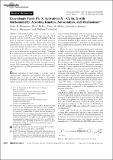Files in this item
Exceedingly facile Ph−X activation (X=Cl, Br, I) with ruthenium(II) : Arresting kinetics, autocatalysis, and mechanisms
Item metadata
| dc.contributor.author | Miloserdov, Fedor M. | |
| dc.contributor.author | McKay, David | |
| dc.contributor.author | Muñoz, Bianca K. | |
| dc.contributor.author | Samouei, Hamidreza | |
| dc.contributor.author | Macgregor, Stuart A. | |
| dc.contributor.author | Grushin, Vladimir V. | |
| dc.date.accessioned | 2016-02-18T16:40:11Z | |
| dc.date.available | 2016-02-18T16:40:11Z | |
| dc.date.issued | 2015-06-02 | |
| dc.identifier | 193113533 | |
| dc.identifier | 3715a4cf-e90a-4a2a-8579-090fb7b94859 | |
| dc.identifier | 84947864322 | |
| dc.identifier.citation | Miloserdov , F M , McKay , D , Muñoz , B K , Samouei , H , Macgregor , S A & Grushin , V V 2015 , ' Exceedingly facile Ph−X activation (X=Cl, Br, I) with ruthenium(II) : Arresting kinetics, autocatalysis, and mechanisms ' , Angewandte Chemie International Edition , vol. 54 , no. 29 , pp. 8466–8470 . https://doi.org/10.1002/anie.201501996 | en |
| dc.identifier.issn | 1521-3773 | |
| dc.identifier.other | Bibtex: urn:d92b0e510e58795f3ae82dc48fb074d3 | |
| dc.identifier.other | ORCID: /0000-0003-0362-7848/work/29608113 | |
| dc.identifier.uri | https://hdl.handle.net/10023/8263 | |
| dc.description | The ICIQ Foundation and The Spanish Government (Grant CTQ2011-25418 and the Severo Ochoa Excellence Accreditation 2014-2018 SEV-2013-0319) are thankfully acknowledged for support of this work. F.M.M. is grateful to the Government of Spain (MICINN) for the FPI Ph.D. Scholarship (BES-2012-054922). S.A.M. and D.M. thank the EPSRC for support through award EP/J010677/1. | en |
| dc.description.abstract | [(Ph3P)3Ru(L)(H)2] (where L=H2 (1) in the presence of styrene, Ph3P (3), and N2 (4)) cleave the Ph[BOND]X bond (X=Cl, Br, I) at RT to give [(Ph3P)3RuH(X)] (2) and PhH. A combined experimental and DFT study points to [(Ph3P)3Ru(H)2] as the reactive species generated upon spontaneous loss of L from 3 and 4. The reaction of 3 with excess PhI displays striking kinetics which initially appears zeroth order in Ru. However mechanistic studies reveal that this is due to autocatalysis comprising two factors: 1) complex 2, originating from the initial PhI activation with 3, is roughly as reactive toward PhI as 3 itself; and 2) the Ph[BOND]I bond cleavage with the just-produced 2 gives rise to [(Ph3P)2RuI2], which quickly comproportionates with the still-present 3 to recover 2. Both the initial and onward activation reactions involve PPh3 dissociation, PhI coordination to Ru through I, rearrangement to a η2-PhI intermediate, and Ph[BOND]I oxidative addition. | |
| dc.format.extent | 778891 | |
| dc.language.iso | eng | |
| dc.relation.ispartof | Angewandte Chemie International Edition | en |
| dc.subject | Ar-X activation | en |
| dc.subject | autocatalysis | en |
| dc.subject | DFT calculations | en |
| dc.subject | kinetics | en |
| dc.subject | ruthenium | en |
| dc.subject | QD Chemistry | en |
| dc.subject | NDAS | en |
| dc.subject.lcc | QD | en |
| dc.title | Exceedingly facile Ph−X activation (X=Cl, Br, I) with ruthenium(II) : Arresting kinetics, autocatalysis, and mechanisms | en |
| dc.type | Journal article | en |
| dc.contributor.institution | University of St Andrews. School of Chemistry | en |
| dc.identifier.doi | 10.1002/anie.201501996 | |
| dc.description.status | Peer reviewed | en |
| dc.identifier.url | http://dx.doi.org/10.1002/anie.201501996 | en |
| dc.identifier.url | http://dx.doi.org/10.1002/ange.201501996 | en |
This item appears in the following Collection(s)
Items in the St Andrews Research Repository are protected by copyright, with all rights reserved, unless otherwise indicated.

